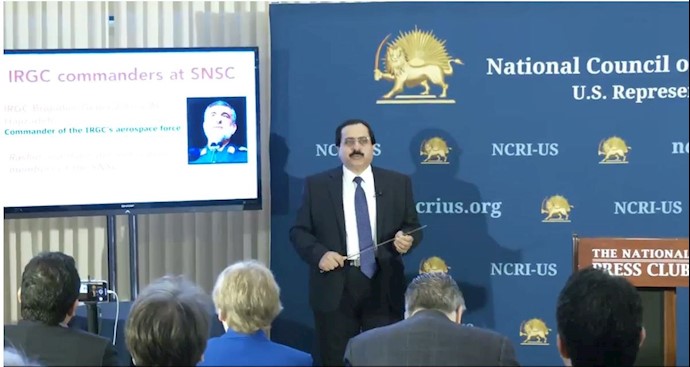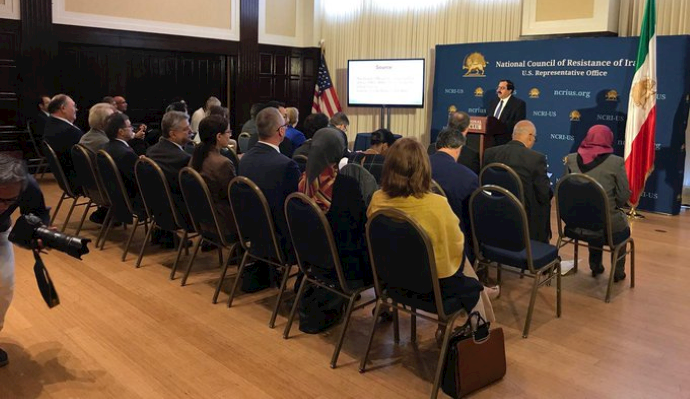Reporting by PMOI/MEK
Washington, September 30, 2019—On Monday, representatives of the Iranian opposition coalition National Council of Resistance of Iran (NCRI) held a press conference at the National Press Club of Washington, DC, revealing new details on the Iranian regime’s September 14th attack on Saudi Arabia’s Aramco oil installations.

Ms. Soona Samsami, NCRI-US representative
Ms. Soona Samsami, the NCRI’s U.S. Representative, launched this conference by providing preliminary details into the chain process behind this attack and the necessary steps that need to be implemented by the international community vis-a-vis the regime in Iran.
Ms. Soona Samsami, U.S. Representative of the National Council of Resistance of Iran
“Based on intelligence obtained by the Iranian opposition People’s Mojahedin Organization of Iran (PMOI/MEK) from inside the Iranian regime, the decision for this attack was taken in the Supreme National Security Council (SNSC), presided over by regime President Hassan Rouhani,” Samsami said in her opening remarks. “Foreign Minister Mohammad Javad Zarif is also a regular member of the SNSC and attends its sessions. A number of Revolutionary Guards (IRGC) commanders attended this meeting.
“The operation’s tactical headquarters led by IRGC brigadier general Mohammad Fallah deployed to the Omidiyeh base in southern Khuzestan province, southwest of Iran, a week before the attack. Missile experts were also transferred to this base prior to the attack.
“The theocracy in Iran has entered the final phase of its demise. The regime tries to prop itself up and prevent an uprising through suppression and sponsorship of terrorism against its opposition. The regime attempts to contain the anger of the society, blackmail the international community into inaction and retreat through warmongering.
“If the regime ceases these activities, it will implode. The regime has paid no price for these actions and silently occupied Iraq.
“Our intelligence shows that the regime’s calculus is that it won’t pay any heavy price until the 2020 U.S. presidential elections. This is the reasoning behind its attack against the U.S. drone, piracy and the attack against Saudi Arabia.
“Mrs. Maraym Rajavi said, ‘The attack on a neighboring country’s oil installations is a major step and a new phase in the warmongering policies of the religious fascism in Iran which demands firm action. The ultimate solution is to change this illegitimate regime by the Iranian people and their resistance, the PMOI/MEK.’”
NCRI-US Deputy Director Alireza Jafarzadeh shed more light into the details of the Iranian regime decision-making hierarchy behind this attack, along with the various bases and types of missiles used for this missile/drone strike.

Alireza Jafarzadeh, Deputy Director, NCRI-US
“The decision was made by Ali Khamenei. Top IRGC commanders were involved in the planning. The information we’re revealing today comes from the network of MEK inside Iran. They have obtained this information from their sources from inside the regime and the IRGC,” Jafarzadeh said.
“When Khamenei decided to make this attack, the SNSC convened to discuss this issue. The final decision was made in an SNSC session on July 29.
The plan was Khamenei's brain child… The operation’s tactical command HQ was deployed from Tehran one week prior to the attack.@WhiteHouse @SecPompeo @StateDept pic.twitter.com/muDEVF0qWZ
— NCRI-U.S. Rep Office (@NCRIUS) September 30, 2019
“SNSC meeting have presided over the Hassan Rouhani. Zarif regularly attends these meetings. Also present in these meetings were IRGC commanders. Major General Gholamali Rashid—you want to remember his name—his role could be more important than others. He is the commander of the Khatam garrison, which is in charge of coordinating all military operations that the regime engages in. He reports directly to Khamenei. Every activity that any military force does comes under his command. He attended the SNSC meeting on July 29.
“Also present in the meeting was IRGC commander Hossein Salami and IRGC-QF commander Ghassem Soleimani. Also present was Amir Ali Hajizadeh, the commander of the IRGC Aerospace Force.
“Rashid and Hajizadeh were summoned to the SNSC session because of their special functions regarding this particular attack.
IRGC BGen Mohammad Fallah, operational deputy comdr of the IRGC Aerospace Force, took the lead in implementation. This operational HQ is situated in Dastvareh base, located in Chitagar region of northwest Tehran.@WhiteHouse @SecPompeo @StateDept pic.twitter.com/0BrYqtoam2
— NCRI-U.S. Rep Office (@NCRIUS) September 30, 2019
“After Khamanei’s order, the issue was discussed in the July 31 SNSC meeting. After that, they started designing the details of the plan, then sent to Khamenei for final approval. Afterward, Rashid and Hajizadeh started implementing the steps for the attack.
“Mohammad Fallah, Hajizadeh’s Deputy was deployed to the base in southern Iran to oversee the operation.
“The details of the attack were worked out in the Chitgar aerospace base in Tehran. After reviewing the final operations, Rashid deployed aerospace commanders to Khuzestan. This was September 7, a week before the attack.
NCRI-US Press Conf on attack on Saudi oil installations:
Alireza Jafarzadeh: The regime’s supreme leader Ali Khamenei directly ordered the attack whose operation involved the highest levels of the IRGC… @WhiteHouse @SecPompeo @StateDept pic.twitter.com/fjSPbCqBdJ— NCRI-U.S. Rep Office (@NCRIUS) September 30, 2019
“These commanders deployed to to Khuzestan province:
Mohammad Fallah, Deputy Commander of Khatam Garrison
Mahmoud Bagheri Kazemabad, commander of the missiles department
Saeid Aghjani, commander of drone forces
These were the kinds of weapons used in the attacks against the Saudi oil installations.
IRGC MGens Hossein Salami, comdr in chief of the IRGC; Qassem Soleimani, comdr of the Qods Force; Gholam-Ali Rashid, comdr of the Khatam-ol Anbiya Central HQ; and BGen Amir-Ali Hajizadeh, comdr of the IRGC’s Aerospace Force; were also present. @WhiteHouse @SecPompeo @StateDept pic.twitter.com/qBIGk7TwUb
— NCRI-U.S. Rep Office (@NCRIUS) September 30, 2019
“In Khuzestan, the commanders were sent to the Omidiyeh base, 35km southeast of Ahvaz. This was previously the 5th interceptor base of Iran’s air force. Units of regular army air defense are stationed in the base. It’s not an official IRGC base, which gives them a good cover.
“A section of the base was used by the aerospace force. Another group of IRGC commanders and personnel who had expertise on missiles and drones were sent to Mahshahr to participate in this operation.
“The operational commanders reported their activities in detail to Rashid. The commanders in Omidiyeh returned to Mahshahr after the operations. A few remained in Omidiyeh.
IRGC MGen Rashid, comdr of the Khatam-ol Anbiya Central HQ, reviewed &approved the final operational plan. The operational comdrs of the IRGC Aerospace Force were deployed from Tehran to Omidiyeh base in Khuzestan prov on Sept 7, a week prior to attack.@WhiteHouse @SecPompeo pic.twitter.com/547MSNoVuy
— NCRI-U.S. Rep Office (@NCRIUS) September 30, 2019
“Based on the latest report we’ve received from inside Iran, a Squad missile team has entered the Omidiyeh base on September 22. We’re watching the situation.
“The missiles were produced by the Thamen ol-Aemeh Cruise missile group. A research facility was also involved.
“The missiles were produced at Parchin, a very large military base near Tehran. It has 12 different sections which deal with different activities of Iran’s regime, including their nuclear weapons program. The Cruise missiles the regime has used in this operation were produced in section 4 of Parchin.
Another group of IRGC comdrs/personnel with expertise in missiles & drones was transferred from the IRGC’s 3rd Naval Region in Mahshahr (75 miles south of Ahvaz) to the Omidiyeh base to participate in this operation. @WhiteHouse @SecPompeo @StateDept pic.twitter.com/dfCVwzQICK
— NCRI-U.S. Rep Office (@NCRIUS) September 30, 2019
“The simultaneous attack on Saudi oil facilities was a blatant act of war by the Iranian regime. The regime is desperate to export its crises beyond its borders. They are counting on the inaction of the international community, so they can manipulate and gain concessions from the west. The only way to eliminate the threat of the regime is to change the regime by the people and their resistance.”
Jafarzadeh concluded his remarks by suggesting concrete steps to address the malign activities of the Iranian regime:
– Implementing UN Security Council resolutions on banning enrichment, etc.
– Removing Iran’s proxies from Yemen, Syria, Iraq, etc
– Looking into the human rights dossier of the regime. Referring to the dossier of the 1988 massacre of political prisoners to international tribunals. Recognizing the right of the Iranian people to resist.





